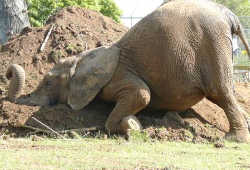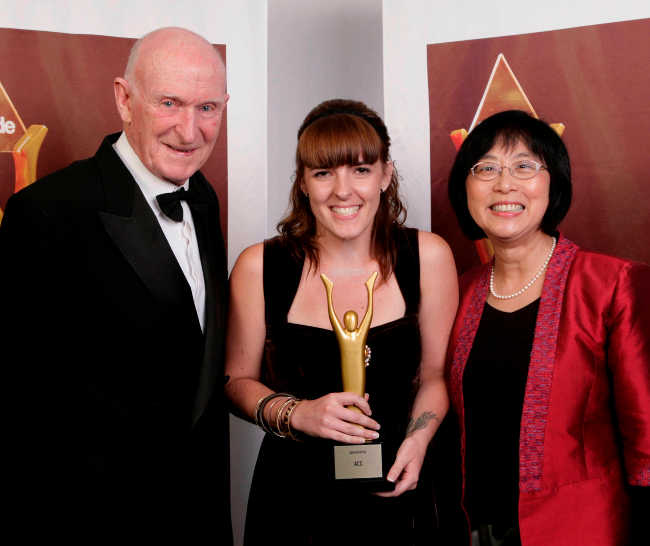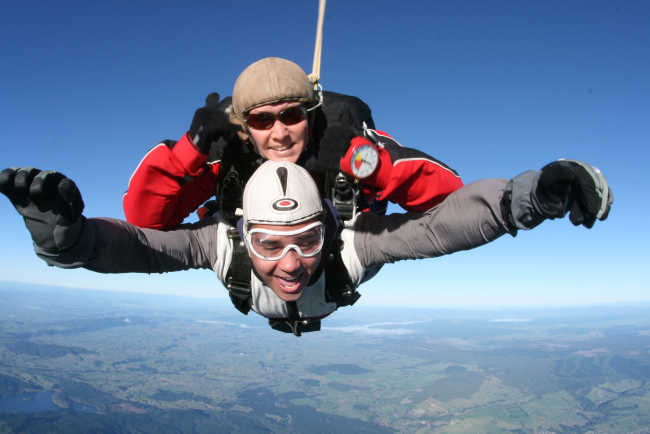An interview with Robert Barrett Dorothy – 19/03/03
The next generations of Barretts follow in the farming tradition on Banks Peninsula Robert Barrett followed the family tradition and took up farming on Banks Peninsula. After serving in the army in the Korean War he obtained a Rehabilitation farm at Kaituna Valley and he and his wife Kay worked hard to make a success of this small holding. When dairy farming was no longer viable they changed to sheep farming and raising cattle for calf production. Robert comments on the changing situation from farming when he began to conditions for farmers like his son Peter in 2003.
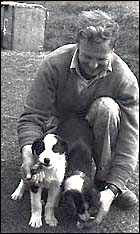 |
| Robert Barrett. |
Working on remote farms Robert left Akaroa High School when he was sixteen. Undeterred by the hard life of his farming family he followed in the path of his forebears and started casual work on isolated local farms, mainly shearing in the bays behind Akaroa – Long Bay, Stony Bay, Flea Bay. Like the Barrett family ‘s land, farms in these bays had difficult access. Robert went there on horseback.
In later years, after coming back from Korea, Robert bought a little A40 truck to go shearing and do casual work which made a great difference.
People wanting to go from Stony Bay to the road out had to ride to Long Bay and go from there by car. Mail was delivered at the cab stand at the top of the hill on the Summit Road. Once or twice a week someone would ride up there to get the newspapers, mail and bread. Wool could be taken out by truck along the dirt roads when the weather was dry. It was taken from Stony Bay by boat.
The farming families tried to be self-sufficient. They had good vegetable gardens and there was plenty of fish in the bay at that time. The main diet for meat was mutton. Most of the farms milked a cow and made their own butter. When Robert first started working there in the late forties they had no electricity. The plant in the shearing sheds was powered by petrol engines. At Stony Bay there was a generating plant powered from the water wheel with an alternative of using diesel. Long Bay was the first to get electricity from the national supply.
Shearing in Canterbury and Australia Then Robert joined another shearer and worked in North Canterbury on stations like Emu Plains and Mendip Hills where the sheds were larger. Shearing mainly finished in January, and in the rest of the year he worked at Flea Bay doing fencing and other farm work, or picked apples in Nelson. One winter he tried to get shearing in Australia, but this did not work out. He did general farm work fencing and grubbing bathhurst burr. After another season’s shearing back home he joined the New Zealand army and served in the Korean War for two years from 1951 to 1953.
The Rehabilitation Board grants Robert a Returned Serviceman’s loan After his return he sat a grading for a Rehabilitation (Rehab) Farm. This involved sitting down before a panel of men experienced in farming and answering questions on knowledge of farming. Robert was a successful applicant and was granted a loan to buy land in Kaituna Valley on Banks Peninsula.
The farm had been turned down in the early days for a rehab farm because of the gorse which has long been a problem on Banks Peninsula. Only when farms became harder to get was it passed for a Rehab loan.
All the farm’s earnings went to the State Advances Corporation and the farmer was put on a budget of eight pounds a week. All the ordinary living expenses had to be paid out of this sum – items such as food not produced on the farm, clothes, toll charges for phone calls outside the valley, and transport costs.
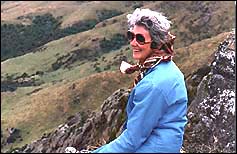 |
| Kay looks across the farm from a point high on the hills. |
Marriage, family and financial management In 1958, Robert met and married Kay Buick, a city girl from Christchurch. Kay proved to be a very practical farmer’s wife, a capable cook, gardener and dressmaker and good with animals.
She and Robert developed a beautiful and productive garden. They had their own milk, eggs and mutton and fruit from their orchard. Rows of bottled fruit provided meals out of season and there was always home baking to have with cups of tea. Their combined practical skills and good money management meant that they were able to cope with bringing up their three children on the limited wage paid to the Rehab farmers.
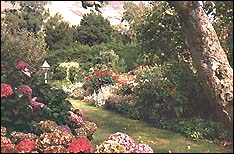 |
| The garden at Kaituna. |
The farm The Kaituna farm was 500 acres running 800 ewes and 20 cows. Robert built a dairy and milked the twenty cows and had a few run cattle. He dropped the ewe count back to 750 and grazed 200 hoggets. 750 ewes at that time was regarded as an economic unit. Eventually he extended the farm, buying another 140 acres and increasing the ewe flock to 900.
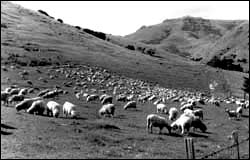 |
| Sheep on the farm in 1965 |
Horses and dogs were essential to the work on the farm. Spraying for gorse was done by hand knapsack. The photo below taken in 1958 shows Robert on his horse Volo, with Jean, the Clydesdale, loaded with water for the spraying. As always he is accompanied by his faithful dogs, Jimmy and Turk.
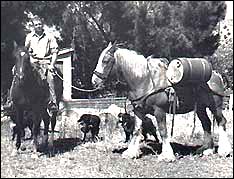 |
| Robert sets out to spray gorse. |
After the first two years the financial position improved as farming moved into more prosperous times. Wool was 75% of the farm’s income, whereas now it is only 10%. During the sixties and seventies with good prices for farm produce Robert was able to do quite a lot of development – fencing for subdivision into paddocks, buying some additional land, and getting aerial topdressing. When the pilot came to do topdressing he stayed at the farm, sometimes staying a week until the wind came right.
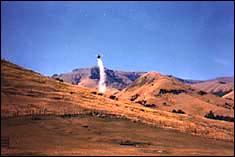 |
| Aerial Topdressing in Kaituna Valley |
The end of dairying Robert continued milking the cows until the late 1980s. He was forced out of dairy production because the farm was no longer on the cream route from the Tai Tapu Dairy Company. Cream collection is now obsolete. He was given the option of extending the herd to a hundred cows on tanker supply. As he didn’t have enough flat land to milk that number on his farm he gave up the cows and runs cattle for breeding calves. He would also have had to spend a large sum of money to upgrade the dairy. Robert’s farmer son, Peter, had no wish to milk cows. Robert bought some more land at Tai Tapu and used this for grazing hoggets.
No aerial topdressing No aerial topdressing has been done in the valley for some years because farmers cannot afford it. The cost of topdressing has increased while the income from farm produce has dropped. Now small four wheel drive trucks spread fertiliser on the less steep hills.
Schooling In the early days of settlement in the valley there were two schools, one at the top and one near the Akaroa Road. These were closed many years ago and the Barrett children had to travel to Tai Tapu. At first the school bus went to the farm gate, but when there were fewer children further up the valley they had to go to the Kaituna Reserve where they left their bikes against the fence – with no worries about them being stolen! At that time houses were never locked when people went out for the day, but it is a different story today.
Transport For many years the train from Christchurch to Little River provided essential transport for people, stock and produce from the foot of the Akaroa Hill Road to the city. The last passenger train on this line ran on 14 April 1951, and the line was closed on 30 June 1962. For Robert at Akaroa High School the annual treat was a trip by bus to Little River and train to Christchurch to play in a country schools sports tournament.
The women in the valley When Kay first came to the valley the women were fully occupied on their farms and almost no women had paid jobs after marriage. Now nearly all the younger women on the lifestyle blocks go to Christchurch to work – a distance of 40km. On some of the lifestyle blocks the women are the farmers. Kay holds office in the Garden Club and the Red Cross and comments that few of the younger rural women join because they are involved with their jobs.
Semi-retirement Robert and Kay have handed over the management of the farm to their son Peter, but Robert assists him with farm work and they still live in the farmhouse and maintain their beautiful garden. Peter is the fifth generation Barrett to farm on the Peninsula.
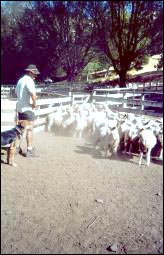 |
| Like the four earlier generations of Barrett farmers, Peter works the sheep with his dog. |
Robert’s comments on farming in 2003 “My own role offering assistance to my son Peter is less demanding physically and I have no responsibility for decisions about the farm. I leave those to Peter and I don’t interfere when his way is different from how I did things.
“It is very hard for young people wanting to start farming as the small holdings are not so viable. The Akaroa valley where my father had his farm has now been turned into lifestyle blocks which are not nearly as productive.
“Farmers now need a larger unit and land is becoming more and more expensive. Today banks won’t lend large sums to farmers unless they have 3000 stock units – considered the minimal economic unit. To buy land and start with this number of units the cost would be between $700,000 and $1,000,000. Banks will lend money for additional land depending on the amount of equity and security the farmer has.
“The measurements for stock units are: one sheep counts as one stock unit one dairy cow counts as five stock units beef cattle count as four stock units each.
“Peter now has an additional 150 acres of hill country opposite our main farm and also leases another 130 acres, which brings his stock numbers in a normal year to approximately 1800 stock units, but he still does casual farm work on other farms.
“When the Rehab farms were being developed dairy farmers were expected to milk at least 45 cows. Now dairy farmers milk 500 to 1000 cows, while some have up to 2000 cows.
“When I came to the valley there were four other Rehab farmers, but I am the only original Rehab farmer left, and our son Peter has now taken over the farm. This has happened on another Rehab farm in the valley. The valley now has a dairy farm, an orchard, and a number of lifestyle blocks.
“Other demands on the farmer today include meeting hygiene regulations, having the herd tested for Tb, and ensuring calves have eartags at weaning.
“When I started there was a control on Land Aggregation through the Land Court, but now there is no control on the area a person can hold. Even on the Peninsula some land owners have several farms. The really good farms like Hickory Bay which has a lovely beach frontage, often go to overseas buyers. Some of the overseas buyers are only looking for an investment, even buying them through the Internet without seeing them.
Forestry “Forestry is being developed on more and more farms on the marginal land. For pines there can be a return in 25 years, for gums in 30 years, but for oaks farmers will have to wait nearly 50 years for a return on the outlay.
Vineyards “Vineyards are being developed in many areas of New Zealand, and this has happened on the Peninsula with the vineyard at French Farm being one of the earliest. There are now vineyards in Kaituna Valley.
Irrigation important in times of drought “At this time three quarters of New Zealand is experiencing drought conditions and the large dairy company Fonterra has announed that dairy production figures are down. However, thanks to irrigation, Canterbury’s production is normal.
Looking back “Given my time again I think I would choose to be a farmer, but if there had been more choice of farms when I bought in Kaituna I would have preferred somewhere not so prone to frequent droughts and with not so many gorse problems.”
A valley where farmers work and city people enjoy recreation Christchurch people may visit Kaituna Valley to picnic and walk in the scenic reserve or to walk the walkway to the Packhorse Hut – a walkway which starts on the Barretts’ land. Many of the visitors have little idea of the difficulties farmers have faced and still face in this beautiful valley.
Photos for this article were supplied by Robert Barrett
For more of the Barrett story go to
Part 1.

